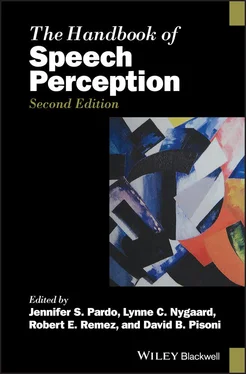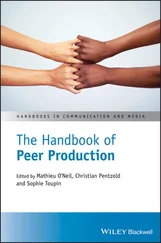Vocal production in nonhuman primates has long been associated with suppressed neural firing in the auditory cortex (Muller‐Preuss & Ploog, 1981), which occurs just prior to the onset of vocalization (Eliades & Wang, 2003). The same effect has been shown in humans, whereby vocalization led to suppression of one third of superior temporal gyrus neurons during open brain surgery (Creutzfeldt, Ojemann, & Lettich, 1989). This suppression preceded vocalization by approximately 100 ms and subsided about 1 second post‐vocalization (Creutzfeldt, Ojemann, & Lettich, 1989). In contrast, when another person spoke in the absence of self‐vocalization by the recorded individual, temporal gyrus activity was not suppressed. Therefore, it is postulated that the same cortical regions that suppress auditory stimuli are responsible for the production and control of speech. In terms of auditory feedback, studies using unanesthetized marmoset monkeys have confirmed that specific neuron populations in the auditory cortex are sensitive to vocal feedback whereas others are not (Eliades & Wang, 2008). Neurons that are suppressed during speech production show increased firing in response to altered feedback, and thus appear to be more sensitive to errors during speech production (Eliades & Wang, 2008). At the same time, a smaller proportion of neurons that are generally excited during production show reduced firing in response to altered feedback (Eliades & Wang, 2008). Although these neural response changes could in principle be due to changes in the vocal signal as a result of feedback perturbations, playing recordings of the vocalizations and altered vocalizations does not change the differential neuronal firing pattern in response to altering the sound (Eliades & Wang, 2008).
Muller‐Preuss and Ploog (1981) found that most neurons in the primary auditory cortex of unanesthetized squirrel monkeys that were excited in response to a playback of self‐vocalization were either weakened or completely inhibited during phonation. However, approximately half of superior temporal gyrus (primary auditory cortex) neurons do not demonstrate that distinction (Muller‐Preuss & Ploog, 1981). This ultimately reflects phonation‐dependent suppression in specific populations of auditory cortical neurons. Electrocorticography data in humans has also supported the idea that specific portions of the auditory cortex are supporting auditory feedback processing (Chang et al., 2013).
In a magnetoencephalography (MEG) study, Houde and colleagues (2002) investigated directly whether vocalization‐induced auditory cortex suppression resulted from a neurological comparison between an incoming signal (auditory feedback) and an internal “prediction” of that signal. They created a discrepancy, or “mismatch,” between the signal and expectation by altering the auditory feedback. Specifically, participants heard a sum of their speech and white noise that lasted the duration of their utterance. The authors found that, when feedback was altered using the gated noise (speech plus white noise), self‐produced speech no longer suppressed M100 amplitude in the auditory cortex. Suppression was observed during normal self‐produced speech. Therefore, these findings support a forward model whereby expected auditory feedback during talking produces cortical suppression of the auditory cortex.
In order to determine whether a forward model system truly regulates cortical suppression of the human auditory cortex during speech production, Heinks‐Maldonado and colleagues (2005) examined event‐related potentials (N100) during speech production. Like Houde et al. (2002), they found that the amplitude of N100 was reduced in response to unaltered vocalization relative to both pitch shifted and speech from a different voice. Furthermore, during passive listening, neither perturbation produced any N100 amplitude differences. This suggests that suppression of the auditory cortex is greatest when afferent sensory feedback matches an expected outcome specifically during speech production (Heinks‐Maldonado et al., 2005).
Functional magnetic resonance imaging (fMRI) studies have broadly concurred with the electrophysiological evidence. For example, Tourville, Reilly, and Guenther (2008) compared the blood‐oxygen‐level‐dependent (BOLD) response in trials when there was a first formant feedback shift to trials in which there was no modification of the auditory feedback. This comparison showed activation in posterior temporal regions consistent with previous findings in which noise masked the speech (Christoffels, Formisano, & Schiller, 2007), auditory feedback was delayed (Hashimoto & Sakai, 2003), vocal pitch feedback was altered (Zarate & Zatorre, 2008 and MEG studies of pitch shifts: Franken et al., 2018). Tourville, Reilly, and Guenther (2008) also reported greater activity in the shift–no shift comparison in the right‐hemisphere ventral premotor cortex for trials in which the first formant was shifted. They interpreted their findings as support of the DIVA model components that perform auditory‐error detection and compensatory motor responses.
These studies and many others support the existence of neural mechanisms that use the auditory character of the talker’s speech output to control articulation. However, the challenge of mapping high‐level computational models to behavioral and neural data remains. The necessity of different levels of description and the units within the levels are difficult to determine. In short, while there may be only a single neural architecture that manages fluent speech, many abstract cognitive models could be consistent with this architecture (see Griffiths, Lieder, & Goodman, 2015, for a discussion of constraints on cognitive modeling). An additional approach is to examine ontogeny for relationships between perception and production.
Auditory feedback and vocal learning
Much is made about the uniqueness of human language and at the speech level, the frequent focus of these uniqueness claims is on the perceptual skills of the developing infant. However, the less emphasized side of communication, speaking, is clearly a specialized behavior. Humans are part of a small cohort of species that are classified as vocal learners and who acquire the sounds in their adult repertoire through social learning (Petkov & Jarvis, 2012). This trait seems to be an example of convergent evolution in a few mammalian (humans, dolphins, whales, seal, sea lions, elephants, and bats) and bird (songbirds, parrots, and hummingbirds) species. The behavioral similarities shown by these disparate species are mirrored by their neuroanatomy and gene expression. In a triumph of behavioral, genetic, and neuroanatomic research, a consortium of scientists has shown similarities in brain pathways for vocal learners that are not observed in species that do not learn their vocal repertoires (Pfenning et al., 2014).
As shown by the studies of deafness summarized earlier, hearing is vital for vocal learning. However, the role that auditory feedback plays in speech development is unclear. There are few human developmental studies that manipulate feedback in the early stages of speech development. Jones and colleagues (Scheerer, Liu, & Jones, 2013; Scheerer, Jacobson, & Jones, 2016, 2019) have shown that children as young as two years of age show compensation for F0 perturbations. However, feedback perturbation of segmental properties such as vowel formant frequency shows a different pattern of results. MacDonald et al. (2012) tested children at two and four years of age, as well as adults in a formant feedback perturbation paradigm. By the age of four, young children acted like adults and partially compensated in response to F1 and F2 perturbations. At the age of two, however, the toddlers showed two significant patterns in response to feedback perturbations (see Figure 4.2). On average there was no evidence of compensatory behavior when the two‐year‐old children were presented with altered feedback of vowel formants. Further, they produced utterances that were remarkably variable. Variability is one of the hallmarks of early speech and birdsong development. But what role does this variability play in development and does feedback processing have a developmental profile? We will return to this question.
Читать дальше








![О Генри - Справочник Гименея [The Handbook of Hymen]](/books/407356/o-genri-spravochnik-gimeneya-the-handbook-of-hymen-thumb.webp)



